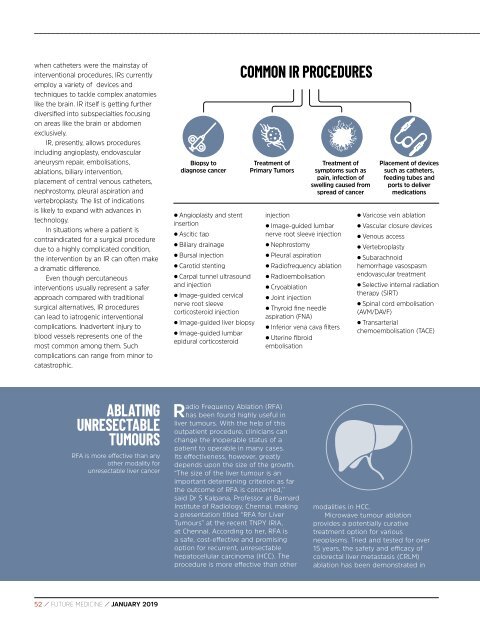FM JANUARY 2019 - digital edition
Create successful ePaper yourself
Turn your PDF publications into a flip-book with our unique Google optimized e-Paper software.
when catheters were the mainstay of<br />
interventional procedures, IRs currently<br />
employ a variety of devices and<br />
techniques to tackle complex anatomies<br />
like the brain. IR itself is getting further<br />
diversified into subspecialties focusing<br />
on areas like the brain or abdomen<br />
exclusively.<br />
IR, presently, allows procedures<br />
including angioplasty, endovascular<br />
aneurysm repair, embolisations,<br />
ablations, biliary intervention,<br />
placement of central venous catheters,<br />
nephrostomy, pleural aspiration and<br />
vertebroplasty. The list of indications<br />
is likely to expand with advances in<br />
technology.<br />
In situations where a patient is<br />
contraindicated for a surgical procedure<br />
due to a highly complicated condition,<br />
the intervention by an IR can often make<br />
a dramatic difference.<br />
Even though percutaneous<br />
interventions usually represent a safer<br />
approach compared with traditional<br />
surgical alternatives, IR procedures<br />
can lead to iatrogenic interventional<br />
complications. Inadvertent injury to<br />
blood vessels represents one of the<br />
most common among them. Such<br />
complications can range from minor to<br />
catastrophic.<br />
Biopsy to<br />
diagnose cancer<br />
• Angioplasty and stent<br />
insertion<br />
• Ascitic tap<br />
• Biliary drainage<br />
• Bursal injection<br />
• Carotid stenting<br />
• Carpal tunnel ultrasound<br />
and injection<br />
• Image-guided cervical<br />
nerve root sleeve<br />
corticosteroid injection<br />
• Image-guided liver biopsy<br />
• Image-guided lumbar<br />
epidural corticosteroid<br />
COMMON IR PROCEDURES<br />
Treatment of<br />
Primary Tumors<br />
injection<br />
• Image-guided lumbar<br />
nerve root sleeve injection<br />
• Nephrostomy<br />
• Pleural aspiration<br />
• Radiofrequency ablation<br />
• Radioembolisation<br />
• Cryoablation<br />
• Joint injection<br />
• Thyroid fine needle<br />
aspiration (FNA)<br />
• Inferior vena cava filters<br />
• Uterine fibroid<br />
embolisation<br />
Treatment of<br />
symptoms such as<br />
pain, infection of<br />
swelling caused from<br />
spread of cancer<br />
Placement of devices<br />
such as catheters,<br />
feeding tubes and<br />
ports to deliver<br />
medications<br />
• Varicose vein ablation<br />
• Vascular closure devices<br />
• Venous access<br />
• Vertebroplasty<br />
• Subarachnoid<br />
hemorrhage vasospasm<br />
endovascular treatment<br />
• Selective internal radiation<br />
therapy (SIRT)<br />
• Spinal cord embolisation<br />
(AVM/DAVF)<br />
• Transarterial<br />
chemoembolisation (TACE)<br />
ABLATING<br />
UNRESECTABLE<br />
TUMOURS<br />
RFA is more effective than any<br />
other modality for<br />
unresectable liver cancer<br />
Radio Frequency Ablation (RFA)<br />
has been found highly useful in<br />
liver tumours. With the help of this<br />
outpatient procedure, clinicians can<br />
change the inoperable status of a<br />
patient to operable in many cases.<br />
Its effectiveness, however, greatly<br />
depends upon the size of the growth.<br />
“The size of the liver tumour is an<br />
important determining criterion as far<br />
the outcome of RFA is concerned,’’<br />
said Dr S Kalpana, Professor at Barnard<br />
Institute of Radiology, Chennai, making<br />
a presentation titled “RFA for Liver<br />
Tumours” at the recent TNPY IRIA,<br />
at Chennai. According to her, RFA is<br />
a safe, cost-effective and promising<br />
option for recurrent, unresectable<br />
hepatocellular carcinoma (HCC). The<br />
procedure is more effective than other<br />
modalities in HCC.<br />
Microwave tumour ablation<br />
provides a potentially curative<br />
treatment option for various<br />
neoplasms. Tried and tested for over<br />
15 years, the safety and efficacy of<br />
colorectal liver metastasis (CRLM)<br />
ablation has been demonstrated in<br />
52 / FUTURE MEDICINE / <strong>JANUARY</strong> <strong>2019</strong>


















